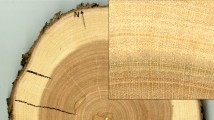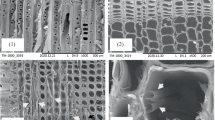Summary
Eighteen healthy and thirty nine diseased firs (Abies alba Mill.) of young and old growth from four sites have been investigated by biological and micro-biological methods in order to contribute to the explanation of the fir dieback.
The sapwood of diseased trees had a lower moisture content than that of healthy ones.
The most striking alteration in the woody tissue of diseased trees is the development of wetwood which spreads irregularly into the sapwood, thus reducing the water-conducting area in the trunk considerably. This wetwood is most predominant in the butt and in the roots near the butt. It is always associated with bacteria which act on the parenchymatic cells by means of their metabolic substances such as acetic-, propionic-, and butyric acid. This in turn causes a decrease of the pH value of the capillary liquid from about 5.5–6.0 to 4.2. The most important strains of bacteria involved were identified asCorynebacterium (micro-aerophilic),Enterobacteria of the genusErwinia orKlebsiella, Staphylococcus (facultatively anaerobic),Clostridium and lactic acid producing bacteria (anaerobic). These bacteria were unable to consume components of the wood in vitro except for a hemicellulose. These bacteria infect the firs through existing wounds. In trees of already reduced vitality this induces a generalizing disease which may eventually lead to the tree’s death.
Similar content being viewed by others
Literatur
Bauch, J., 1980: Variation of wood structure due to secondary changes. Mittg. Bundesforschungsanstalt für Forst-und Holzwirtschaft, Hamburg-Reinbek Nr.131, 69–98.
Bauch, J.;Höll, W.;Endeward, R., 1975: Some aspects of wetwood formation in fir. Holzforschung29, 198–205.
Bauch, J.;Klein, P.;Frühwald, A.;Brill, H., 1978: Veränderungen der Holzeigenschaften der Weißtanne (Abies alba Mill.) durch das «Tannensterben», Allg. Forstz.33, 1148–1449.
—, 1979: Alterations of wood characteristics inAbies alba Mill. due to «fir-dying» and considerations concerning its origin. Eur. J. For. Path9, 321–331.
Bergey’s manual of determinative bacteriology, 1974:Buchanan, R. E. andN. E. Gibbons, co-editors. 8. edition. The Williams and Wilkins Company, Baltimore.
Blaschke, H., 1980: Feinwurzeluntersuchungen und biotische Aktivitäten in der Rhizosphäre vom Tannensterben befallener Abies alba-Bestände. Eur. J. For. Path.10, 181–185.
Börtitz, S., 1968: Physiologische und biochemische Beiträge zur Rauchschadenforschung. 7. Mitteilung. Einfluß letaler SO2-Begasungen auf’den Stärkehaushalt von Koniferennadeln. Biol. Zbl.87, 63–70.
Börtitz, S., 1968: Physiologische und biochemische Beiträge zur Rauchschadenforschung. 8. Mitteilung. Untersuchungen über die Wirkung von SO2 auf den Stoffwechsel von Koniferennadeln im Winter. Biol. Zbl.87, 489–506.
Brill, H., 1981: Holzbiologische und mikrobiologische Untersuchungen zur Klärung der Ursachen für das Tannensterben. Diss. FB Biologie, Univ. Hamburg.
Eichhorn, O., 1981: Zoologische Aspekte des Tannensterbens. Forstw. Cbl.100, 270–275.
Evers, F.H., 1981: Ergebnisse ernährungskundlicher Erhebungen zur Tannenerkrankung in Baden-Württemberg. Forstw. Cbl.100, 253–265.
Fink, S.;Braun, H.J., 1978: Zur epidemischen Erkrankung der Weißtanne Abies alba Mill. I. Untersuchungen zur Symptomatik und Formulierung einer Virose-Hypothese. Allg. Forst-u. Jagdz.149, 145–150.
Frühwald, A.;Klein, P.;Bauch, J., 1981: Über die Holzeigenschaften der vom Tannensterben betroffenen Bäume. Forstw. Cbl.100, 207–217
Guderian, R., 1970: Untersuchungen über quantitative Beziehung zwischen dem Schwefelgehalt von Pflanzen und dem Schwefeldioxidgehalt der Luft. III. Teil Z. Pfl. Krankh.77 (415), 387–399.
Guenin, J.-L., 1979: Biologische Untersuchungen an Nadeln, Rinden und Holz von gesunden und erkrankten Weißtannen (Abies alba Mill.). Dipl.-Arb., FB Biologie, Univ. Hamburg.
Hartley, C.; Davidson, R. W.; Crandall, B.S., 1961: Wetwood, bacteria and increased pH in trees. U.S. For. Prod. Lab. Rep. 2215, 35 S.
Kelman, A., 1979: How bacteria induce disease. In: Plant Disease. An advanced treatise, Vol. IV, Academic Press, 181–202.
Klein, P.;Bauch, J.;Frühwald, A., 1979: Naßkerneigenschaften von Tannenholz. Holz-Zbl.105, 1465–1466.
Knabe, W., 1976: Internationale Konferenz über die Wirkung saurer Niederschläge. Forstarch. 47, 236–239.
Lang, K.J., 1981: Anatomische Befunde im Naßkernbereich der Wurzel. Forstw. Cbl.100, 180–183.
Leibundgut, H., 1974: Zum Problem des Tannensterbens. Schweiz. Zeitschrift für Forstwesen125, 476–484.
Maramarosch, K., 1974: Mycoplasmas and Rickettsiae in relation to plant diseases. Ann. Rev. Microbiol.28, 301–324.
Berchtold, R., et. al., 1981: Standortskundliche Studien zum Tannensterben. Forstw. Cbl.100, 236–253.
Rorison, J.H., 1973: The effects of extreme soil acidity on the nutrient uptake and physiology of plants. in: H. Dost ed. Acid Sulphate Soils I, 223–254, Wageningen.
Schmidt, O., 1980: Über den bakteriellen Abbau der chemisch behandelten verholzten Zellwand. Material und Organismen15, 207–224.
Schuck, H. J.;Blümel, U.;Geier, L.;Schütt, P., 1980: Schadbild und Ätiologie des Tannensterbens. I. Wichtung der Krankheitssymptome. Eur. J. For. Path.10, 125–135.
Schütt, P., 1977: Das Tannensterben. Der Stand unseres Wissens über eine aktuelle und gefährliche Komplexkrankheit der Weißtanne (Abies alba Mill.). Forstw. Cbl.96, 177–186.
—, 1981a: Ursache und Ablauf des Tannensterbens. Forstw. Cbl.100, 287–289.
—, 1981b: Die Verteilung des Tannennaßkerns in Stamm und Wurzel. Forstw. Cbl.100, 174–179.
Shigo, A.L., 1976: Compartmentalization of discolored and decayed wood in trees. Material und Organismen, Beiheft3, 221–226.
Shigo, A.L.;Hillis, W.E., 1973: Heartwood, discolored wood and microorganisms in living trees. Ann. Rev. Phytopathol.11, 197–222.
Tiedemann, G.;Bauch, J.;Bock, E., 1977: Occurrence and significance of bacteria in living trees ofPopulus nigra L. Eur. J. For. Path.7, 364–374.
Ulrich, B.; Mayer, R.; Khanna, P.K., 1979: Deposition von Luftverunreinigungen und ihre Auswirkungen in Waldökosystemen im Solling. Schriften aus der Forstl. Fakultät der Univ. Göttingen u. der Nieders. Forstl. Versuchsanstalt, B. 58, Sauerländer Verlag.
Ward, J.C.;Zeikus, J.G., 1980: Bacteriological, chemical and physical properties of wetwood in living trees. Mittg. Bundesforschungsanstalt für Forst-und Holzwirtschaft, Hamburg-Reinbek Nr.,131, 133–166.
Author information
Authors and Affiliations
Rights and permissions
About this article
Cite this article
Brill, H., Bock, E. & Bauch, J. Über die Bedeutung von Mikroorganismen im Holz von Abies alba Mill. für das Tannensterben. Forstw Cbl 100, 195–206 (1981). https://doi.org/10.1007/BF02640636
Published:
Issue Date:
DOI: https://doi.org/10.1007/BF02640636




